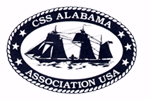
|

Dive Operations
 Latest News Latest News
 Detailed Information Detailed Information
Useful Links
 Naval Historical Naval Historical
Center
 W.S. Hoole W.S. Hoole
Special Collections
Library at the
University of
Alabama
|

|

|

|
Article 18
(June 7, 2004 - Cherbourg, France)
It has been far too long since our last update. For this we apologize.
This was in part due to the planned hiatus in underwater operations until
time and resources are issues are resolved. The following is a summary
update and is extracted from a preliminary report prepared by
Dr. Gordon P. Watts, Jr., Ph.D., Principal Investigator on Project C.S.S.
ALABAMA Challenge.
During June and July 2002, the American C.S.S. Alabama Association and the
French Association C.S.S Alabama carried out an archaeological investigation
of the remains of the Confederate commerce raider C.S.S Alabama. Under the
direction of Dr. Watts American and French archaeologists, French volunteer
divers and French Navy personnel cooperated in an examination of the wreck
between 29 May and 27 July 2002. An underwater archaeological investigation
of the wreck site between 30 May and 21 June 2002. Objectives for the
investigation included video and 35mm photographic documentation of both the
wreck and underwater research activities. Continued test excavation in a
previously tested area aft in the officers' quarters and limited excavation
within the hull forward in the crews' quarters were the focus of archaeological
investigation. In addition to small "at risk" artifacts, a number of large items
including the aft pivot gun, the aft fire suppression pump and the galley stove
were identified for possible recovery. At the conclusion of the diving operations,
the focus of on-site activity shifted to video and 35mm documentation of the
wreck site to generate data for the production of a site mosaic and computer
model of the surviving wreck structure. Between 5 and 21 July, a remote operated
vehicle (ROV) was employed to conduct that documentation. For the C.S.S Alabama
project the ROV was equipped with an acoustic positioning system, a high-resolution
digital still camera and an underwater video system.
Because funding for the
2002 investigation was not released in time to make sufficient preparations or
to obtain and test equipment, a number of the research objectives were compromised.
Excavation was frustrated by equipment problems. Artifact recovery, although
highlighted by the C.S.S Alabama's bell, was limited to salvaging a random
collection of material. Diver and ROV documentation of the exposed vessel remains
generated more than 2,000 images. Due to the lack of acoustic positioning for both
divers and the ROV and problems with an untested digital camera system, much of the
photographic data is of limited value in constructing a comprehensive scaled mosaic.
Proposed high-resolution multi-beam imaging of the wreck was not carried out due to
weather and other research priorities. Without question, the most important lesson
to be learned from the 2002 investigation of C.S.S Alabama is the liability inherent
in attempting to plan, organize, equip and carry out a complex international underwater
archaeological investigation without sufficient time and resources.
Project results obtained to date include the recovery of more than 300 artifacts
including cannons, ship's bell, ship's, structural samples, tableware, ornate commodes,
and numerous other items that reveal much about life aboard the Confederate warship.
During the life of the project two televised documentaries , thousands of images, and
reports have been made available to the public. We feel that the project has yielded
an enormous amount of information and a goodly number of artifacts, especially in the context of the dollars expended.
|
|

|
